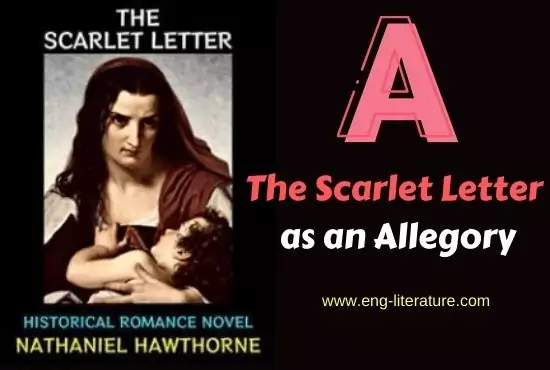
The Scarlet Letter as an Allegory
The allegory is the Puritan form of art. Puritans believed in life as a cosmic struggle between the forces of good and evil. Milton, Bunyan, Spenser, all were great allegorists who saw the world in black and white. They clothed good and evil in conventional terminologies and made them fight battles in which Christian always reached the Celestial City, i.e. the good triumphed over the evil. Hawthorne’s mind was too subtle for him to accept the Puritan’s world-picture. Yet, he was too much of the Puritan’s son to understand the complexity of the human world. Therefore, he wrote Romances in which the broad Puritan artistic view of clothing ideas in words was put into practice. Yet, he found that life could not be classified so easily. His symbolism and ambiguity is an acknowledgement of the variety and mysteries of life.
As many people feel (Yvor Winters, the eminent American critic, is among these). Hawthorne’s fiction is mainly allegorical. That is, we have a struggle between the personified Good and Evil, and then the ultimate triumph of good over the evil in his books. To these critics, Hester is the complete repentant Dimmesdale , a half-repentant, and Chillingworth unrepentant. There is then, a moral at the end, for every man to be true to himself and the others Hawthorne “selected sexual sin as the type of all sin” (Yvor Winters: Maule’s Curse).
There is static characterization (character embody ideas and ideologies. They are not real human beings as in novel). The Scarlet Letter is, in this view, an illustrated sermon on the consequences of sin. Hawthorne a modern writer was using the allegory form to show to the Puritans “the limits of their intelligences” (i.e. world-picture).
Hawthorne knows what he wants to say, and says it effectively in his illustrated sermon of The Scarlet Letter, “a great allegory about sin and its consequences. Yet, Yvor Winters grants that Hawthorne had rejected the simple Puritan thought and concepts, and had looked at them from a more complex point of view than his forefathers had. Hawthorne wanted to dress abstractions of thought into the “poetry” of his fiction, but he failed to do so because he ignored the “immediacy” (concreteness) of life in his fiction. All this criticism is only an extension of the theory that the Scarlet Letter is a Romance and not a novel.
Yet, the very ambiguity and symbolism of the Scarlet Letter makes it difficult for us to believe that it is only an allegorical romance. It does have ideas clothed is persons and weak characterization, but the multiple meanings of the fable (the story) make it more of a modern symbolical novel rather than an allegory. Mrs. O, D. Lenvis (in her essay, “Hawthorne as a Poet”) and Charles Fiedelson, Jr. (in his book, Symbolism and American Literature) seem to find in Hawthorne more than a mere allegorist.
Also Read:
To Mrs. Leavis, “every portion (of the Scarlet Letter) is concentrated with meanings and associations and cross-references.” She also talks about Hawthorne’s preoccupation with the cultural and the psychological’ at the time. Pearl herself is not a Puritan child but a person opting for the fuller, richer (more concrete and complex) life of Europe. Mrs. Leavis then discusses the poetry of The Scarlet Letter and says that Hawthorne’s achievement was decisive for the American novel. (That is great American writers like Melville and Henry James own their art to him)
Charles Fiedelson, Jr. talks about the multiple meanings of a symbol (as differentiated from the limited meaning of an allegory) and makes one of the most important statements on Hawthorne’s art. “Allegory was the brake that Hawthorne applied to his sensibility. For allegory was analytic…The symbolistic and the allegorical patterns in Hawthorne’s books reach quite different conclusions of rather, the symbolism leads to an inconclusive luxuriance of meaning Le “ambiguity”.
We agree with Fiedelson, Jr. The Scarlet Letter may, in parts, read like an allegory or an illustrated sermon. It is also a modern symbolical novel with a hidden depth of meaning upon meaning, as D.H. Lawrence also suggested in his perceptive essay on Hawthorne in his Studies in the Classical American Literature.

Hello, Viewers! Besides being the Founder and Owner of this website, I am a Government Officer. As a hardcore literary lover, I am pursuing my dream by writing notes and articles related to Literature. Drop me a line anytime, whether it’s about any queries or demands or just to share your well-being. I’d love to hear from you. Thanks for stopping by!